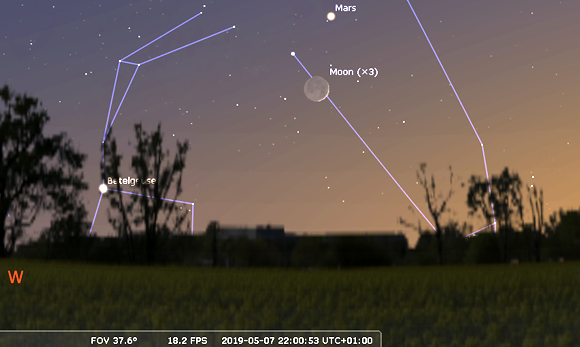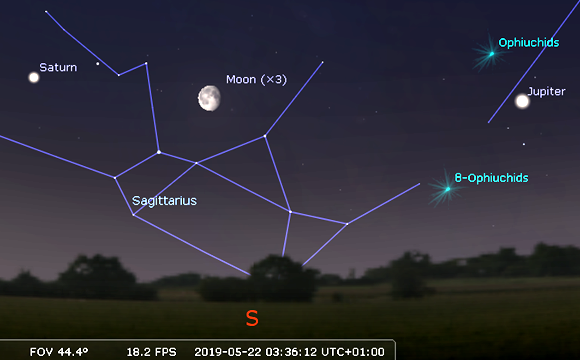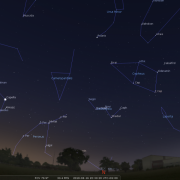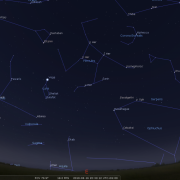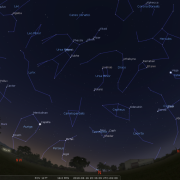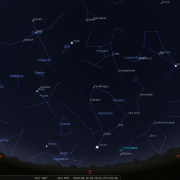
Welcome to the WDAS monthly newsletter for May 2019: a digest of the month's latest contributions to our website. Below you'll find Society News covering the Star Party laid on for staff and students of Ayresome Primary School at Whitby Youth Hostel; up-coming events, Mark's Crossing-the-line article for month, the latest about the observatory refurb; and, of course, Sky Notes including Opposition of Ceres.
Society News
 Staying at the Whitby Youth Hostel, this year’s outward bounds party from Ayresome Primary school in Middlesbrough once again brought fine weather with them, even though the forecast originally had been for light or low cloud for much of the week.
Staying at the Whitby Youth Hostel, this year’s outward bounds party from Ayresome Primary school in Middlesbrough once again brought fine weather with them, even though the forecast originally had been for light or low cloud for much of the week.
This turned out to be somewhat off the mark, with our preferred evening (Wednesday 10th) being clear and still. Actually some cloud did come in off the sea, but not enough to really hamper our observations.
Having arrived around 20:00h, it was much easier setting up the equipment on the Hostel approach forecourt area in bright twilight. Libby Lavelle, assistant head teacher of Ayresome Primary School, came out from the hostel to greet us, and after warming tea’s and coffee’s, Libby went back and gathered up the 25 or so pupils indoors and sent them out.

19-Apr-2019: Set-up and cloud-cover assessment
As customary, before any observing commenced, Mark, with assistance from the pupils, demonstrated the scale solar system along the Hostel approach drive, using both the marked string and inflatable planets. The only actual visible planet in the sky, Mars, was pointed out over in the west to the right of Aldebaran.
Five scopes were in use for observations: Andy L’s reflector, Keith’s Dobsonian, Lee’s reflector along with the two Dobsonians Mark had brought. Transport logistics had been a little tricky, but once again Barbara and Mark came to the rescue and were on hand to assist.

The pupils were quite excited to view the waxing crescent moon, and pressed round the scopes eagerly. They soon got the hang of lining up alongside the instruments.
Using the laser pointers, the spring sky constellations, setting winter groups as well as prominent circumpolar stars, were pointed out. For the majority of pupils present it seemed a revelation to be able to trace out the constellations in the sky, which we gathered are barely visible from many areas in Middlesbrough itself.
It also came as a revelation that artificial satellites are visible from the ground, those ‘moving star points’ - not shooting stars as someone thought (alas we didn’t see any of those) but the man made artefacts we have come to rely on for so many hidden aspects of our lives.

19-Ap-2019: Sky Tour in Progress. (Photo by Keith)
One great bonus that evening was the identification of the minor planet (asteroid) Pallas, which lay close by Muphrid in Bootes. Although it only looked like a ‘faint star’, the fact that we knew it would be in that position, at that time, on that date, just by looking at a planetarium program or App on a screen, really did ‘blow’ a few minds.
After a final question and answer session, (many questions and some answers) it was time for the pupils to return into the hostel. We had been favoured with the weather and i think we passed on that favour to the pupils. Libby will let us know feedback from the group once the term recommences. Thanks again to Andy, Keith, Lee and Barbara and Mark for their time.
 We are currently awaiting news from the college regarding the estimate submitted for the proposed work on the observatory, plus any subsequent developments on their part. However some preparations will commence at the next bank holiday (May Day weekend).
We are currently awaiting news from the college regarding the estimate submitted for the proposed work on the observatory, plus any subsequent developments on their part. However some preparations will commence at the next bank holiday (May Day weekend).
A proposal has been made to utilise the Sunday evening observing slot (now in abeyance until after the summer period) to carry out preparatory and remedial work within the observatory. This will be discussed at the final monthly meeting for this season in May.
If the Moon had been at a better phase, (ie. pre Full Moon), we could have almost started the outdoor star party season at Easter, with the weather being as good as it was. But it was rising just a little too late, and with no planets visible – (Mars being well passed its best) the spring sky is not ideally suited to the passing public.
We shall therefore wait for the next favourable lunar phase before we commence the star party events season. Here then is the diary for the next couple of months. The dates listed below are for May and June scheduled events, (weather permitting. If you can join us, (especially if you can bring a telescope along) it would be most appreciated. Hope to see you.
Sky Notes
In this month's Sky Notes:
Planetary Skylights
Evening Planets
 Mars remains the solitary naked eye planet visible in the evening sky until near the month end, but is gradually being overwhelmed by the lighter evenings. As dusk falls look for it low in the WNW at the start of the month between the ‘horn tip’ stars; zeta and beta tauri, in Taurus. The red planet then glides up into Gemini, clipping the northern edge of the open cluster M35, although that this whole area is slipping down to the horizon. The moon lies close by on the 7th.
Mars remains the solitary naked eye planet visible in the evening sky until near the month end, but is gradually being overwhelmed by the lighter evenings. As dusk falls look for it low in the WNW at the start of the month between the ‘horn tip’ stars; zeta and beta tauri, in Taurus. The red planet then glides up into Gemini, clipping the northern edge of the open cluster M35, although that this whole area is slipping down to the horizon. The moon lies close by on the 7th.
A crescent Moon accompanies Mars at the beginning of May; and a waning moon
is accompanied by Saturn and Jupiter towards the end of May. Click for full-sized images.
 At the very end of the month Mercury makes a so-so evening appearance, joining Mars in the early June sky. Look for a reasonably ‘bright star’ very low to the NW horizon approximately 45 minutes after sunset.
At the very end of the month Mercury makes a so-so evening appearance, joining Mars in the early June sky. Look for a reasonably ‘bright star’ very low to the NW horizon approximately 45 minutes after sunset.
 The early morning sky is home to the solar systems two largest planets; Jupiter and Saturn. Conspicuous Jupiter begins the month rising as a morning object, visible above the SE horizon by 1am. It ends the month rising as a late evening object, visible as twilight deepens (around 22:30h). Jupiter resides to the right of the ‘Teapot’ asterism in Sagittarius and is moving in retrograde motion against the backdrop of stars. At magnitude -2.55 it continues to brighten as it heads towards opposition on June 10th.
The early morning sky is home to the solar systems two largest planets; Jupiter and Saturn. Conspicuous Jupiter begins the month rising as a morning object, visible above the SE horizon by 1am. It ends the month rising as a late evening object, visible as twilight deepens (around 22:30h). Jupiter resides to the right of the ‘Teapot’ asterism in Sagittarius and is moving in retrograde motion against the backdrop of stars. At magnitude -2.55 it continues to brighten as it heads towards opposition on June 10th.
Observations will be a little tricky for a while with regard to timings, this aside from the fact Jupiter (and Saturn) are both low on the ecliptic and hence not very high above the horizon. The choice is therefore to rise very early or wait until the month’s end and stay up late, thereafter Jupiter will become increasingly an evening object, albeit in the light skies of summer.
If you do make the effort, there is always something of interest to view in the eyepiece, especially as the disc is a whopping 46 arc seconds in size. So whether it’s the cloud band features, or the dance of the Galilean moons, Jupiter is a fine object to follow. Our moon pays Jupiter a visit on the 21st.
Jupiter Galilean moon shadow transits, dates of interest as follows:
7th, 13th, 14th, 20th, 28/29th and 31st . Events between 23:35h and 03:30h.
The great red spot transits on the disk on the following dates:
1st, 5/6th, 10/11th, 15/16th, 17/18th, 21-25th, 27/28/29/30th all between 01.15h and 03:45h.
 Saturn trails Jupiter into the sky by just a couple of hours and although not as conspicuous is nevertheless quite prominent to the naked eye. It resides to the left of the ‘teapot’ asterism - pretty low to the horizon, so observations are going to be somewhat compromised due to our atmosphere. Turn a telescope towards its soft pearly hue and you should see the distinctive rings, which are currently orientated very favourably. Have patience and wait for those steadier ‘seeing’ moments. The moon lies nearby on the 23rd.
Saturn trails Jupiter into the sky by just a couple of hours and although not as conspicuous is nevertheless quite prominent to the naked eye. It resides to the left of the ‘teapot’ asterism - pretty low to the horizon, so observations are going to be somewhat compromised due to our atmosphere. Turn a telescope towards its soft pearly hue and you should see the distinctive rings, which are currently orientated very favourably. Have patience and wait for those steadier ‘seeing’ moments. The moon lies nearby on the 23rd.
 Venus is technically visible very low to the east horizon less than 30 minutes before sunrise.
Venus is technically visible very low to the east horizon less than 30 minutes before sunrise.
Ceres at Opposition
Following the opposition of Pallas last month, the largest dwarf planet, Ceres, reaches opposition at the end of May. You will need to observe around midnight to spot it, as it lies in the southern part of Ophiuchus, bordering Scorpius.
At magnitude +7.0 Ceres should be readily visible in 10x50 binoculars, but a small telescope may be the best instrument to track it down. Approaching 600 miles in diameter, Ceres is spherical in shape, accounting for perhaps one third of the mass of the asteroid belt between Mars and Jupiter.
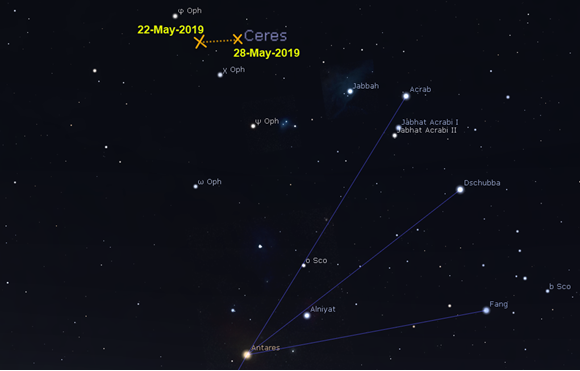
Finder Chart for Ceres, towards the end of May 2019.
In 2015 Ceres was visited by the NASA DAWN spacecraft, which sent pictures back of this rock and ice world. The observing window is best before the 10th or after the 22nd around 1am local time. You will require a flat south east aspect as Ceres will be 15-20 degrees above the horizon by the end of May. Ceres is roughly heading to east to west slightly above and left of beta Scorpii. See chart for details. Good hunting.
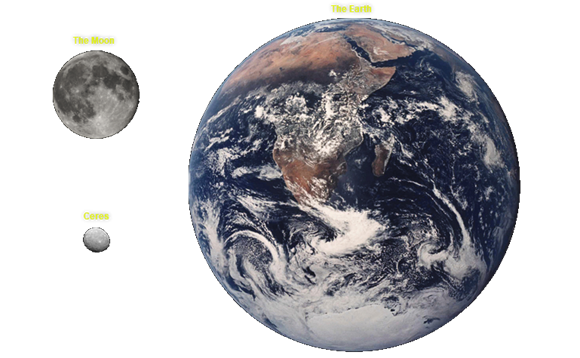
Size Comparison of Ceres next to Earth and the Moon. Image from Wikipedia Commons.
Meteors

If you are a very early riser, look out for some shooting stars around May 5th-7th, when the eta Aquarid meteor shower reaches a peak. The actual peak falls on the 6th. This is one of two meteor showers associated with debris particles deposited over time by comet Halley, the other shower being the Orionids seen in late October.
Eta Aquarids have a ZHR (zenith hourly rate) approaching 30, but with Aquarius only just rising in the SE shortly before dawn, observations from the UK are always somewhat restricted. The radiant of the shower lies close to eta Aquarius, one of the stars making up the "water jar" in the otherwise faint constellation of Aquarius. View around 4am to the south and east.
May 2019 Sky Charts
|
Looking North
Mid-May - 22:30h |
Looking South |
|
Looking East
Mid-May - 22:30h |
Looking West
Mid-May - 22:30h |
|
Northern Aspect
Mid-May - 22:30h |
Southern Aspect
Mid-May - 22:30h |
| Looking North (Early) Mid-May - 03:15h |
Looking South (Early) Mid-May - 03:15h |
Additional Image Credits:
- Planets and Comets where not otherwise mentioned: NASA
- Sky Charts: Stellarium Software
Continuing the tour of stellar objects crossing the meridian line this month: Alphard: the most northerly star of the River constellation Eridanus.
Star: Alphard – alpha Hydrae, Hydra and the Crow and Cup
Easily visible unassisted.
Chief star in Hydra - the traditional name Alphard is from the Arabic (al-fard), "The Solitary One", no doubt because there are no other bright stars in Alphard’s immediate vicinity. The European astronomer Tycho Brahe dubbed it Cor Hydrae, Latin for 'the heart of Hydra'. At magnitude +1.8 Alphard is a ‘bright’ second magnitude star and lies approximately 177 light years away.

Alphard (Alpha Hydrae) 'The Lonely One'
Probably starting out as a mid B-class star of around three times the mass of the Sun, Alphard, although only around 420-430 million years old, has already evolved away from the main sequence to become a giant star with a spectral classification of K3 and luminosity class of between II and III, equating to a surface temp of 4,300K and approximately 1,000 times our sun’s luminosity. According to theories on stellar evolution, Alphard is already fusing helium into carbon and oxygen deep in its core. Alphard has now swollen to over 55 times the Sun’s radius, which places it among the top three biggest stars of its type, and perhaps only Betelgeuse and R Doradus are larger.
Alphard's spectrum shows a mild excess of barium, an element that is normally produced by the s-process of nucleosynthesis. Typically a barium star belongs to a binary system and the anomalies in abundances are explained by mass transfer from a companion white dwarf star. This arrangement almost always explains the presence of abundances through the mechanism of mass transfer from the white dwarf to the normal star, but in Alphard’s case, no companion star of any type has been identified.
Alphard is also of scientific interest as an object for the study of asteroseismological events. Precise measurements of variations in Alphard’s radial velocities and spectral lines have revealed multi-periodic oscillations, with periods that range from a few hours to several days. These short-term oscillations are thought to be similar to those pulsations that occur on the Sun, but exact reasons for these correlations between the variations in the stars’ spectral line and radial velocity remain to be discovered.
Location
You can locate Alphard to the SW as darkness falls in early May, below and slightly ahead of bright Regulus in Leo.
Hydra, the Water Serpent, is the largest constellation in the heavens, extending from below Cancer in the WSW, to beneath Virgo down in the ESE. Indeed it is well after 23:00h before the entire constellation is visible. In Greek mythology, Leo, Cancer and Hydra are all associated with Hera, Queen of the gods. Both Leo and Hydra were raised as pets by Hera.
Leo’s coat was said to be impervious to fire and metal weapons, whilst the multi-headed snake was empowered with the ability to re-grow its heads; should one be cut off. In the first of his twelve labours, Hercules, whom Hera despised, was tasked with slaying the lion beast ravaging the region of Nemea. He duly trapped the beast in a cave and clubbed it to death. In honour of this deed, Zeus placed the lion in the heavens.
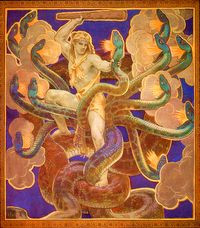 Decidedly miffed by the loss of her pet, Hera then pitted Hercules against the multi headed Hydra, which he overcame by using flaming arrows to cauterise the neck-stumps thus stopping the heads from regenerating. Hera; who saw the snake was in trouble, sent a giant crab (Cancer) to assist Hydra. In the ensuing battle Hercules also crushed the giant crustacean. A distraught Hera then placed both monstrous creatures in the heavens.
Decidedly miffed by the loss of her pet, Hera then pitted Hercules against the multi headed Hydra, which he overcame by using flaming arrows to cauterise the neck-stumps thus stopping the heads from regenerating. Hera; who saw the snake was in trouble, sent a giant crab (Cancer) to assist Hydra. In the ensuing battle Hercules also crushed the giant crustacean. A distraught Hera then placed both monstrous creatures in the heavens.
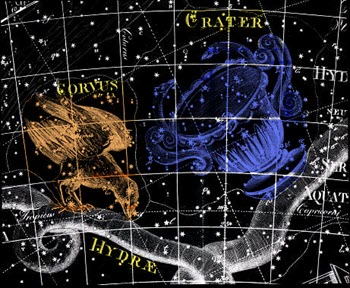 Toward the tail of Hydra, two small but original constellations rest on snakes body; Corvus the Crow and Crater the Cup. Corvus and Crater are linked by one legend in which Apollo sent his pet white crow to fetch a cup of water. The bird flew off with the cup in his talons, but tarried, waiting for the fruit of a fig tree to ripen. On his return Corvus tried to convince Apollo that Hydra the water snake had delayed him. Apollo did not believe the bird and in a rage turned the crow black, dispatching him to the sky close to Crater, which is just out of the thirsty bird’s reach.
Toward the tail of Hydra, two small but original constellations rest on snakes body; Corvus the Crow and Crater the Cup. Corvus and Crater are linked by one legend in which Apollo sent his pet white crow to fetch a cup of water. The bird flew off with the cup in his talons, but tarried, waiting for the fruit of a fig tree to ripen. On his return Corvus tried to convince Apollo that Hydra the water snake had delayed him. Apollo did not believe the bird and in a rage turned the crow black, dispatching him to the sky close to Crater, which is just out of the thirsty bird’s reach.
The outline of Crater is rather faint and difficult to trace in light polluted skies, but from a dark sky location the pattern does somewhat resemble the outline of a cup or goblet. The stars of Corvus are a little more prominent, but are certainly not arranged in the shape of a crow. Instead the grouping is quadrilateral in nature, one which mariners and astronomers sometimes refer to as ‘Spica’s Spanker’, a spanker being a type of sail the outline of which matches Corvus almost exactly. Counting clockwise from top left the stars are Algorab, Gienah, Minkar and Kraz.
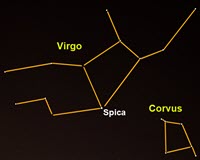 Spica is the bright first magnitude star in Virgo located to the upper left of the crow. There is one messier object (M68) in Hydra, a globular cluster, located below Corvus. Algorab and Kraz point down to it, one third their separation passed Kraz. The other object of note is the planetary nebula NGC 3242, the ‘ghost of Jupiter’, which can be located below right of Crater.
Spica is the bright first magnitude star in Virgo located to the upper left of the crow. There is one messier object (M68) in Hydra, a globular cluster, located below Corvus. Algorab and Kraz point down to it, one third their separation passed Kraz. The other object of note is the planetary nebula NGC 3242, the ‘ghost of Jupiter’, which can be located below right of Crater.
Events
 Observe the night sky with us at the Bruce Observatory, Whitby School
Observe the night sky with us at the Bruce Observatory, Whitby School
Observing Nights are held weather permitting: check for a relatively clear sky before leaving home. If in doubt, Mark can be reached on 07886069339
Please note the college drive gate is now operated via a electronic key code - so anyone wishing to attend must be at the car park at the top of the drive by 19:00hrs - unless an arrival time has been arranged with Mark/Keith.
 Whitby School - Room H1.
Whitby School - Room H1.
In Members' monthly meetings we usually take a tour of the night sky for the coming month using the Planetarium program. Have talks and presentations on various topics of astronomy/space etc, and discuss future events etc. New members welcome.
 Observe the night sky with us at the Bruce Observatory, Whitby School
Observe the night sky with us at the Bruce Observatory, Whitby School
Observing Nights are held weather permitting: check for a relatively clear sky before leaving home. If in doubt, Mark can be reached on 07886069339
Please note the college drive gate is now operated via a electronic key code - so anyone wishing to attend must be at the car park at the top of the drive by 19:00hrs - unless an arrival time has been arranged with Mark/Keith.
 Observe the night sky with us at the Bruce Observatory, Whitby School
Observe the night sky with us at the Bruce Observatory, Whitby School
Observing Nights are held weather permitting: check for a relatively clear sky before leaving home. If in doubt, Mark can be reached on 07886069339
Please note the college drive gate is now operated via a electronic key code - so anyone wishing to attend must be at the car park at the top of the drive by 19:00hrs - unless an arrival time has been arranged with Mark/Keith.
 Observe the night sky with us at the Bruce Observatory, Whitby School
Observe the night sky with us at the Bruce Observatory, Whitby School
Observing Nights are held weather permitting: check for a relatively clear sky before leaving home. If in doubt, Mark can be reached on 07886069339
Please note the college drive gate is now operated via a electronic key code - so anyone wishing to attend must be at the car park at the top of the drive by 19:00hrs - unless an arrival time has been arranged with Mark/Keith.
 Whitby School - Room H1.
Whitby School - Room H1.
In Members' monthly meetings we usually take a tour of the night sky for the coming month using the Planetarium program. Have talks and presentations on various topics of astronomy/space etc, and discuss future events etc. New members welcome.


